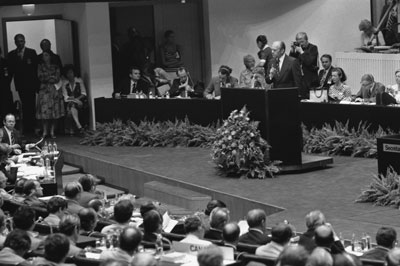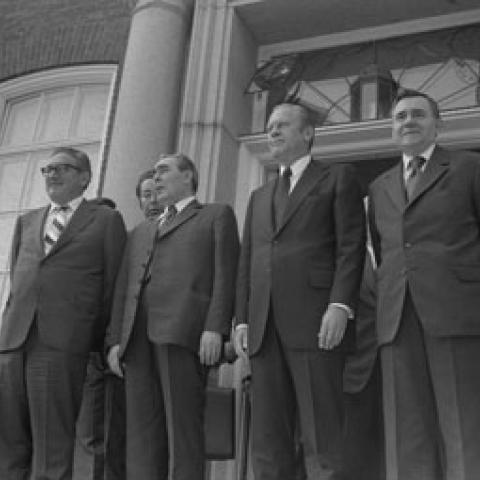
A5755-35. President Ford addresses delegates during the Plenary Session of the Conference on Security and Cooperation in Europe in Finlandia Hall. August 1, 1975.
A5755-35. President Ford addresses delegates during the Plenary Session of the Conference on Security and Cooperation in Europe in Finlandia Hall. August 1, 1975.
The origins of the Conference on Security and Cooperation in Europe (CSCE) go back to 1954 when the Soviet Union first proposed a European security conference in the hopes of formalizing the political boundaries established in Eastern Europe following World War II. The United States and the other Western nations were reluctant to engage in such discussions during the 1950s and 1960s, since they thought it would strengthen the Soviet position and lead to an expansion of communism. With the advent of détente during the early 1970s, the Western leaders reconsidered their stance and began negotiations.
When Gerald R. Ford became President of the United States in August 1974, planning and negotiations for the CSCE were already well underway. Having recognized the need to improve political and economic tensions between Eastern and Western Europe, participating countries had begun negotiating an agreement in 1973. After two years of negotiations, known as the Helsinki Process, 35 nations signed the Helsinki Final Act at a summit meeting in Helsinki, Finland, in the summer of 1975.
The Helsinki Final Act, also known as the Helsinki Accords or the Helsinki Declaration, addressed a variety of issues grouped into four “baskets.” Basket I laid out agreements pertaining to security in Europe and respect for national sovereignty; Basket II discussed economic and trade relations; Basket III focused on human rights and freedom of movement; and Basket IV detailed procedures for future CSCE meetings and implementation of the accords. Although not a treaty or a legally-binding agreement, the Helsinki Final Act constituted a statement of intent between the participating nations.
Participants in the CSCE and signers of the Helsinki Final Act included nearly all of the existing European countries at the time, except for Albania and Andorra, as well as Canada and the United States:
- Austria (Bruno Kreisky, Chancellor)
- Belgium (Leo Tindemans, Prime Minister)
- Bulgaria (Todor Zhivkov, Chairman of the State Council)
- Canada (Pierre Trudeau, Prime Minister)
- Cyprus (Makarios III, President)
- Czechoslovakia (Gustáv Husák, President)
- Denmark (Anker Jørgensen, Prime Minister)
- East Germany (Erich Honecker, First Secretary of the Central Committee of the Socialist Unity Party)
- Finland (Urho Kekkonen, President)
- France (Valéry Giscard d’Estaing, President)
- Greece (Konstantinos Karamanlis, Prime Minister)
- Holy See (Agostino Casaroli, Cardinal Secretary of State)
- Hungary (János Kádár, First Secretary of the Central Committee of the Hungarian Socialist Workers' Party)
- Iceland (Geir Hallgrímsson, Prime Minister)
- Ireland (Liam Cosgrave, Taoiseach)
- Italy (Aldo Moro, Prime Minister)
- Liechtenstein (Walter Kieber, Prime Minister)
- Luxembourg (Gaston Thorn, Prime Minister)
- Malta (Dom Mintoff, Prime Minister)
- Monaco (André Saint-Mleux, Minister of State)
- Netherlands (Joop den Uyl, Prime Minister
- Norway (Trygve Bratteli, Prime Minister)
- Poland (Edward Gierek, First Secretary of the Polish United Workers' Party)
- Portugal (Francisco da Costa Gomes, President)
- Romania (Nicolae Ceauşescu, President)
- San Marino (Gian Luigi Berti, Captain Regent)
- Soviet Union (Leonid Brezhnev, General Secretary of the Communist Party)
- Spain (Carlos Arias Navarro, Prime Minister)
- Sweden (Olof Palme, Prime Minister)
- Switzerland (Pierre Graber, President)
- Turkey (Süleyman Demirel, Prime Minister)
- United Kingdom (Harold Wilson, Prime Minister)
- United States (Gerald Ford, President)
- West Germany (Helmut Schmidt, Chancellor)
- Yugoslavia (Josip Broz Tito, President)
The Helsinki Final Act was initially unpopular and misunderstood in the West, due to concern over the concessions the agreement appeared to give to the Soviet Union. Critics of the accords expressed opposition to what was seen as the official recognition of Soviet domination over the Baltic states of Estonia, Latvia, and Lithuania. However, the document also served as the basis for the creation of the civil rights organization Helsinki Watch, which monitored compliance of Basket III of the Helsinki Accords in Eastern Europe. Ultimately, the impact of the agreement led to the end of the Cold War, including the reunification of Germany, independence for the Baltic states, and the peaceful dissolution of the Soviet Union.
Digital Resources and Galleries
President Ford's Trip to Europe, July - August 1975
Document from the White House Central Files Subject File (IT 104)
- Memo from Henry Kissinger to President Gerald Ford Regarding the Impact of European Security Conference on Baltic States (no date on the document)
Folder from the National Security Adviser's Presidential Transition File
- Letters to and from World Leaders - US-USSR Exchanges, 8/9/74-11/5/74 (The CSCE is discussed on pages 42 - 50)
Folders from the National Security Adviser's Memoranda of Conversations
- August 27, 1974 - Ford, Romanian Presidential Counselor Pungan
- August 28, 1974 - Ford, Kissinger (The CSCE is discussed on pages 10 - 11)
- October 8, 1974 - Ford, Kissinger
- October 8, 1974 - Ford, Kissinger, Edward Gierek of Poland
- December 15, 1974 - Ford, Kissinger, Simon, French President Valery Giscard d'Estaing, Foreign Minister Jean Sauvagnargues (Meeting Two)
Folders from the National Security Adviser's Kissinger Reports on USSR, China and Middle East Discussions
- October 24-27, 1974 - Kissinger/Brezhnev Talks in Moscow (1)
- November 23-24, 1974 - Vladivostok Summit (2) (The CSCE is discussed on pages 21 - 33)
Background Documents - 1975:
- Typed Note from Jerry Jones to Brent Scowcroft Requesting a Reply to President Gerald Ford Regarding the Effects CSCE on Baltic Groups, 3/25/1975
- Memo from Henry Kissinger to Gerald Ford regarding the status of CSCE, 4/30/1975
- Memo from Mr. Clift to Henry Kissinger Regarding President Gerald Ford's Travel Itinerary at Time of CSCE Summit, 6/13/1975
- Statement, by Aleksandr Solzhenitsyn
- Folders from Ron Nessen Papers
- Folder from National Security Adviser's Presidential Country Files for Europe and Canada
- USSR - State Department Telegrams: To SECSTATE - EXDIS (4) (The CSCE is discussed on pages 12 - 20)
- Folders from the National Security Adviser's Memoranda of Conversations
- March 27, 1975 - Ford, Kissinger, Former FRG Chancellor Willy Brandt
- April 1975 (Day Unknown) - Ford, Kissinger
- May 7, 1975 - Ford, Kissinger, UK Prime Minister Harold Wilson, Foreign Secretary James Callaghan
- May 30, 1975 - Ford, Kissinger, British Prime Minister Harold Wilson, Foreign Secretary James Callaghan
- June 16, 1975 - Ford, Kissinger, FRG President Walter Scheel, Minister of Foreign Affairs Hans-Dietrich Genscher
- July 25, 1975 - Ford, Kissinger, Congressmen, Eastern Europe Advocates
- Folders from the Ron Nessen Files
- Folders from the National Security Adviser's Kissinger Reports on USSR, China and Middle East Discussions
- May 19-20, 1975 - Kissinger/Gromyko Meetings in Vienna (1) (The CSCE is discussed on pages 14 - 36 and 51 - 56)
- July 10-11, 1975 - Kissinger/Gromyko Meetings in Geneva (1)
- July 10-11, 1975 - Kissinger/Gromyko Meetings in Geneva (2)
- Folder from the Vernon Loen and Charles Leppert Files
- White House Press Releases
Helsinki Day by Day
July 30, 1975 - Helsinki, Finland:
- Selected Photographs
- After a Bilateral Meeting President Gerald R. Ford and Soviet General Secretary Leonid Brezhnev Pose on the Steps of the American Embassy Residence in Helsinki, Finland, Flanked by Secretary of State Henry Kissinger and Soviet Foreign Affairs Minister Gromyko
- Delegates Seated in Finlandia Hall at the Opening of the Conference on Security and Cooperation in Europe (CSCE) in Helsinki, Finland
- President Gerald R. Ford, Henry Kissinger, and the U.S. Delegation in Finlandia Hall at the Opening of the Conference on Security and Cooperation in Europe (CSCE), in Helsinki, Finland
- Photograph of President Gerald R. Ford and Members of the American Delegation Taking a Break at the Conference on Security and Cooperation in Europe in Helsinki, Finland
- National Security Adviser's Memoranda of Conversation
- White House Press Releases
- Question and Answer Session with the President and Leonid Brezhnev, General Secretary of the Union of Soviet Socialist Republics (Including Translation)
- Press Pool Report #4, Brezhnev Departs and Travel from US Embassy Residence to Finlandia Hall to Embassy Residence
- Heads of Delegation, Conference on Security and Cooperation in Europe (Stage III)
- Press Conference of Henry A. Kissinger, Secretary of State, Finlandia Hall
- List of bilateral meetings held by Secretary Kissinger
- National Security Adviser's Kissinger Reports on USSR, China and the Middle East
July 31, 1975 - Helsinki, Finland:
- Photograph of President Gerald R. Ford's Meeting with Western Leaders in the British Embassy Garden in Helsinki, Finland
- White House Press Releases
- National Security Adviser's Memoranda of Conversation
- Documents from the Presidential Handwriting File
August 1, 1975 - Helsinki, Finland:
- Audio Recording of President Gerald R. Ford Remarks to the Conference on Security and Cooperation in Europe
- Selected Photographs
- President Ford Addressing Delegates during the Plenary Session of the Conference on Security and Cooperation in Europe (CSCE) in Finlandia Hall in Helsinki, Finland
- President Ford Addressing Delegates in Finlandia Hall during the Plenary Session of the Conference on Security and Cooperation in Europe (CSCE) in Helsinki, Finland
- President Gerald R. Ford, Henry Kissinger, and the U.S. Delegation Listening to Discussions in Finlandia Hall during the Conference on Security and Cooperation in Europe (CSCE), in Helsinki, Finland
- President Gerald R. Ford Signing the Final Act of the Conference on Security and Cooperation in Europe as It is Passed Among European Leaders for Signature in Finlandia Hall in Helsinki, Finland
- President Gerald R. Ford and Soviet General Secretary Leonid Brezhnev Raise Their Glasses in a Toast Following the Signing of the Final Act of the Conference on Security and Cooperation in Europe (CSCE), in Helsinki, Finland
- Document from Presidential Handwriting File
- White House Press Releases
Reaction and Implementation of the Helsinki Accords:
- Department of State Bulletin, 9/1/1975
- National Security Adviser's Memoranda of Conversations
- August 5, 1975 - Ford, Japanese Prime Minister Teko Miki (The CSCE is discussed on pages 3 - 5)
- August 8, 1975 - Cabinet Meeting
- September 23, 1975 - Ford, Italian Foreign Minister Mariano Rumor
- September 25, 1975 - Ford, Congressional Leadership (The CSCE is discussed on pages 10 - 16)
- October 14, 1975 - Ford, Kissinger, General Alexander Haig (SACEUR)
- July 16, 1976 - Ford, Kissinger, FRG Chancellor Helmut Schmidt
- July 26, 1976 - Ford, Kissinger, Scowcroft
- August 3, 1976 - Ford, Kissinger, Finnish President Urho Kekkonen
- October 3, 1976 - Ford, Kissinger, Scowcroft (The CSCE is discussed on pages 5 - 7)
- White House Press Releases
- Folders from National Security Adviser's Kissinger-Scowcroft West Wing Office Files
- USSR - "D" File (Dobrynin) Items 122-127 (The CSCE is discussed on pages 4 - 6)
- USSR - Gromyko File (29)
- Folder from National Security Adviser's National Security Council Meetings File
- Folder from the Philip Buchen Files
- Folder from Ron Nessen Files
- Press Secretary Briefings, 4/19/76 (The CSCE is discussed on pages 12 - 13)
- Folder from the National Security Adviser's Presidential Country Files for Europe and Canada
- Folder from the Richard Cheney Files
